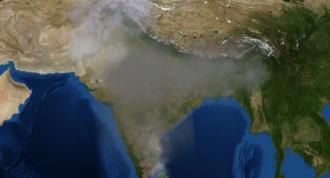Photo: Siddharth Kankaria / Research Matters
As kids, most of us were introduced to various air pollutants and their harmful effects in our books. And as we grew, so did the number of these pollutants and the industries that spew them! Some of these toxic pollutants are known to cause asthma, lung cancer and even death.
Now, researchers from the Indian Institute of Science (IISc), Bangalore have fabricated a novel gas sensor for monitoring air pollution by quantifying various gaseous pollutants. The gas sensor, the researchers say, is very accurate and cost-effective for measuring carbon monoxide (CO), carbon dioxide (CO2), nitrogen dioxide (NO2) and sulphur dioxide (SO2).
The researchers have assembled an array of gas sensors, a microelectromechanical system, on a single chip. Microelectromechanical systems (MEMS) are miniaturized mechanical and electro-mechanical devices ranging from well below one micron (billion times smaller than 1 meter) to several millimeters (1000 times smaller than 1 meter) in their dimensions. “Since they consume a few milliwatts power for operation, they fulfill the current demands for integration in battery operated (portable) devices. This kind of small foot print is not possible to achieve using macro components”, says Prof. Navakanta Bhat from the Centre of Nano Science and Engineering (CeNSE), IISc, who led the study.
This sensor array contains four micro-heaters and four sensor elements made up of sensing materials, where each of them is customized to sense a specific gas: Zinc oxide (ZnO) for CO, Barium titanate-Cupric oxide (BaTiO3-CuO) doped with 1% Silver (Ag) for CO2, Tungsten trioxide (WO3) for NO2 and Vanadium pentoxide (V2O5) for SO2.
Gas sensors usually suffer from insufficient sensitivity to gases, lack of reproducibility, temporal drift, and instability. However, the newly developed sensor array acts as an ‘electronic nose’ due to its enhanced selectivity and sensitivity owing to its different sensing pattern for each gas in a mixture. The data collected from different array elements can be utilized to distinguish constituent gases of the mixture, thus making it capable of onsite monitoring of air pollution.
The researchers designed the new sensor such that it consumed very low power (∼ 10 mW for the micro-heaters to achieve 300°C), was very compact and allowed to control the temperatures of each sensing unit separately, thus being highly selective. Such a feature was made possible by using a stress engineered Silicon dioxide (SiO2) diaphragm made using plasma enhanced chemical vapor deposition. A diaphragm is a platform that hosts all the array elements. It is a chemically inert material that makes it possible to join together with a wide variety of media, thus helping to reduce both the size and cost of the sensor.
One of the investigations that were carried out for optimizing the system was the synthesis process of the diaphragm (SiO2). Taking into account the efficiency of various synthesis routes, the Plasma enhanced chemical vapour deposition demonstrated higher fabrication yield compared to thermally grown SiO2. The investigators carried out simulations of both the diaphragms under thermal, bending and tensile stresses and the yield was found to be higher in the former route.
The researchers also ensured that the new array was not ‘cross-sensing’ interfering gases, a drawback of most metal oxide based sensors. By recording the response of interfering gases, they chose the optimal sensing material, thus eliminating cross-sensing. “We are already evaluating the interference from ambient temperature and humidity and appropriate algorithms can be developed to achieve robust gas sensing performance against all interfering agents”, says Dr. Chandra Shekhar Prajapati, a postdoctoral fellow who worked on this project, talking about the future plans on improving the sensor.
The newly developed micro sensor array finds a lot of applications. “This sensor array technology was developed as a prototype device for air quality monitoring, and is currently being used for selective detection of NO2 at Satish Dhawan Space Centre SHAR, ISRO. The future possibilities include food quality monitoring and breath analysis for disease diagnosis. The miniature size of micro sensors can also enable the integration of such devices in cell phones in the near future.” adds Prof. Bhat.
The need for reliable and low-cost sensors is global. With pollutants accumulating as days pass, sensors help address issues related to public health by augmenting data regarding their quantity, source and distribution as well as develop methods to subside them. In the long run, they could possibly aid in environmental public policy.
Editor's Note: There was a typo in the article that was discovered recently and it was corrected. The error is regretted.






